CheerioLounge
Dessert Dreamer
From Wikipedia:
A tarantula hawk is a spider wasp which hunts tarantulas as food for its larvae. Tarantula hawks belong to any of the many species in the genera Pepsis and Hemipepsis in the family Pompilidae (spider wasps).
The more familiar species are up to five centimeters (two inches) long with a blue-black body and bright rust-colored wings (other species have black wings with blue highlights), making them among the largest of wasps. The coloring on their wings warns potential predators that they are dangerous (aposematism). Their long legs have hooked claws for grappling with their victims. The stinger of a female tarantula hawk can be up to 7 mm (1/3 inch) long, and the sting is considered among the most painful insect stings in the world.
Worldwide distribution of tarantula hawks includes areas from India to Southeast Asia, Africa, Australia, and the Americas. Tarantula hawk species have been observed from as far north as Salt Lake City, Utah in the United States, and south as far as Argentina in South America, with at least 250 species living in South America.[2] Several species of tarantula hawk are found in the deserts of the southwestern United States, with Pepsis formosa and Pepsis thisbe being common. The two species are difficult to distinguish, but the majority of Pepsis formosa have metallic blue bodies and reddish antennae, which separates them from Pepsis thisbe (both species have bright orange wings that become transparent near the tip).
The tarantula hawk is relatively docile and rarely stings without provocation. However the sting, particularly of Pepsis formosa, is among the most painful of any insect, though the intense pain only lasts for about 3 minutes.[3] Commenting on his own experience, one researcher described the pain as "immediate, excruciating pain that simply shuts down one's ability to do anything, except, perhaps, scream. Mental discipline simply does not work in these situations."[2] In terms of scale, the wasp's sting is rated near the top of the Schmidt Sting Pain Index, second only to that of the bullet ant and is described by Schmidt as "blinding, fierce [and] shockingly electric".[4] Because of their extremely large stingers, very few animals are able to eat them; one of the few animals that can is the roadrunner. As many predatory animals avoid these wasps, there are many different insects which are mimics, including various other wasps and bees (Mullerian mimics), as well as moths, flies (e.g., mydas flies), and beetles (e.g., Tragidion) (Batesian mimics)
This is what ours look like:

A tarantula hawk is a spider wasp which hunts tarantulas as food for its larvae. Tarantula hawks belong to any of the many species in the genera Pepsis and Hemipepsis in the family Pompilidae (spider wasps).
The more familiar species are up to five centimeters (two inches) long with a blue-black body and bright rust-colored wings (other species have black wings with blue highlights), making them among the largest of wasps. The coloring on their wings warns potential predators that they are dangerous (aposematism). Their long legs have hooked claws for grappling with their victims. The stinger of a female tarantula hawk can be up to 7 mm (1/3 inch) long, and the sting is considered among the most painful insect stings in the world.
Worldwide distribution of tarantula hawks includes areas from India to Southeast Asia, Africa, Australia, and the Americas. Tarantula hawk species have been observed from as far north as Salt Lake City, Utah in the United States, and south as far as Argentina in South America, with at least 250 species living in South America.[2] Several species of tarantula hawk are found in the deserts of the southwestern United States, with Pepsis formosa and Pepsis thisbe being common. The two species are difficult to distinguish, but the majority of Pepsis formosa have metallic blue bodies and reddish antennae, which separates them from Pepsis thisbe (both species have bright orange wings that become transparent near the tip).
The tarantula hawk is relatively docile and rarely stings without provocation. However the sting, particularly of Pepsis formosa, is among the most painful of any insect, though the intense pain only lasts for about 3 minutes.[3] Commenting on his own experience, one researcher described the pain as "immediate, excruciating pain that simply shuts down one's ability to do anything, except, perhaps, scream. Mental discipline simply does not work in these situations."[2] In terms of scale, the wasp's sting is rated near the top of the Schmidt Sting Pain Index, second only to that of the bullet ant and is described by Schmidt as "blinding, fierce [and] shockingly electric".[4] Because of their extremely large stingers, very few animals are able to eat them; one of the few animals that can is the roadrunner. As many predatory animals avoid these wasps, there are many different insects which are mimics, including various other wasps and bees (Mullerian mimics), as well as moths, flies (e.g., mydas flies), and beetles (e.g., Tragidion) (Batesian mimics)
This is what ours look like:


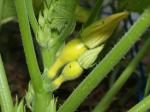
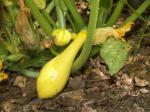
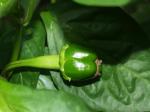
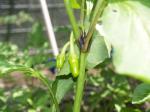
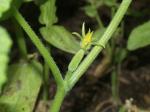

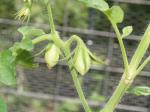
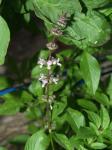
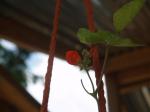
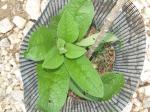
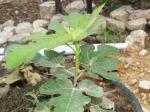
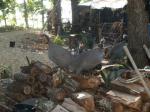
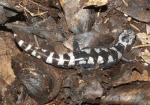
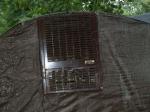

 Thanks, Deb! Glad you enjoy the critter pictures, especially since I feel so fortune to be able to "capture" them with the the camera and share them. The experiences with them feel like gifts/a sign that we are living our lives right here, by doing our best to live with the land.
Thanks, Deb! Glad you enjoy the critter pictures, especially since I feel so fortune to be able to "capture" them with the the camera and share them. The experiences with them feel like gifts/a sign that we are living our lives right here, by doing our best to live with the land.

